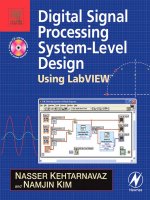shaderx2 introductions and tutorials with directx 9
Bạn đang xem bản rút gọn của tài liệu. Xem và tải ngay bản đầy đủ của tài liệu tại đây (6.63 MB, 393 trang )
ShaderX
2
: Introductions &
Tutorials with DirectX 9
Edited by
Wolfgang F. Engel
ShaderX
2
: Introductions
& Tutorials with
DirectX 9
Edited by
Wolfgang F. Engel
Wordware Publishing, Inc.
Library of Congress Cataloging-in-Publication Data
ShaderX
2
: introductions and tutorials with DirectX 9 / edited by
Wolfgang Engel.
p. cm.
Includes bibliographical references and index.
ISBN 1-55622-902-X (paperback, companion CD-ROM)
1. Computer games Programming. 2. Three-dimensional display systems.
3. DirectX. I. Engel, Wolfgang F.
QA76.76.C672S47 2003
794.8'16693 dc22 2003016311
CIP
© 2004, Wordware Publishing, Inc.
All Rights Reserved
2320 Los Rios Boulevard
Plano, Texas 75074
No part of this book may be reproduced in any form or by any means
without permission in writing from Wordware Publishing, Inc.
Printed in the United States of America
ISBN 1-55622-902-X
10987654321
0307
Crystal Reports is a registered trademark of Crystal Decisions, Inc. in the United States and/or other countries.
Names of Crystal Decisions products referencedherein are trademarks or registered trademarks of Crystal Decisions or its
Screen shots used in this book remain the property of their respective companies.
All brand names and product names mentioned in this book are trademarks or service marks of their respective companies.
Any omission or misuse (of any kind) of service marks or trademarks should not be regarded as intent to infringe on the
property ofothers. The publisher recognizes and respects all marks used by companies, manufacturers, and developers as a
means to distinguish their products.
This book is sold as is, without warranty of any kind, either express or implied, respecting the contents of this book and any
disks or programs thatmay accompany it, including butnot limited to implied warranties for thebook’s quality,performance,
merchantability, or fitness for any particular purpose. Neither Wordware Publishing, Inc. nor its dealers or distributors shall
be liable to the purchaser or any other person or entity with respect toany liability, loss, ordamage caused oralleged to have
been caused directly or indirectly by this book.
All inquiries for volume purchases of this book should be addressed to Wordware
Publishing, Inc., at the above address. Telephone inquiries may be made by calling:
(972) 423-0090
Articles
Introduction to the DirectX High Level Shading Language 1
Craig Peeper and Jason L. Mitchell
Introduction to the vs_3_0 and ps_3_0 Shader Models 63
Nicolas Thibieroz, Kristof Beets, and Aaron Burton
Advanced Lighting and Shading with Direct3D 9 83
Michal Valient
Introduction to Different Fog Effects 151
Markus Nuebel
Shadow Mapping with Direct3D 9 181
Michal Valient
The Theory of Stencil Shadow Volumes 197
Hun Yen Kwoon
Shader Development Using RenderMonkey 279
Natalya Tatarchuk
Tips for Creating Shader-Friendly 3D Models 339
Gim Guan Chua
v
Contents
Preface xiii
About the Authors xvii
Introduction xxi
Introduction to the DirectX High Level Shading Language 1
Craig Peeper and Jason L. Mitchell
Introduction 1
A Simple Example 2
Assembly Language and Compile Targets 4
Hardware Realities 6
Compilation Failure 6
The Command-line Compiler — fxc 7
Language Basics 8
Keywords 8
Data Types 9
Type Modifiers 12
Storage Class Modifiers 13
Initializers 14
Working with Vectors 14
Constructors 15
Type Casting 15
Structures 17
Samplers 17
Intrinsics 19
Math Intrinsics 20
Texture Sampling Intrinsics 23
Shader Inputs 25
Uniform Input 25
Varying Input 27
Shader Outputs 29
An Example Shader 31
Optimization 39
Matrix Data Type Usage 40
vii
Integer Data Type Usage 41
Flow Control and Performance 42
Importance of Input Type Declarations 44
Precision Issues (logp, expp, lit) 45
Using the ps_1_x Compile Targets 46
Strategy for Targeting ps_1_x 51
Integration into an Engine Using D3DX Effects 51
Effect Files 52
The Effect API 57
Integration into an Engine without Using D3DX Effects 58
The Constant Table 59
SDK Updates 61
Conclusion 61
Acknowledgments 61
Introduction to the vs_3_0 and ps_3_0 Shader Models 63
Nicolas Thibieroz, Kristof Beets, and Aaron Burton
Introduction 63
Features Common to vs_3_0 and ps_3_0 64
Flexible Input and Output Declarations 64
Predication 65
Static and Dynamic Flow Control 66
Arbitrary Swizzle 69
Destination Write Masks on Texture Instructions 70
vs_3_0 Features 71
Registers 71
Instructions 73
Texture Sampling 73
Vertex Stream Frequency 76
ps_3_0 Features 78
Registers 78
Instructions 80
Unlimited Texture Samples and Dependent Reads 82
Conclusion 82
References 82
Advanced Lighting and Shading with Direct3D 9 83
Michal Valient
Introduction 83
Per-Pixel Phong 84
Phong’s Lighting Equation 84
Vertex and Pixel Shaders 2.0 85
Vertex and Pixel Shaders 3.0 97
Per-pixel Environment Bump Mapping with Fresnel Term . . . 108
Mathematical Background 109
viii
Contents
Vertex Shader 112
Pixel Shader 1.4 115
Pixel Shader 2.0 117
HLSL Version 119
Background for Advanced Models 122
Spherical Coordinates 122
Roughness of a Surface 123
Masking and Shadowing 124
The Oren-Nayar Model 125
Shaders 127
HLSL Version 131
Cook-Torrance Model 134
Shaders 2.0 136
Shaders 1.4 140
HLSL Version 143
Quality Comparison 147
Conclusion 148
References 149
Introduction to Different Fog Effects 151
Markus Nuebel
Introduction 151
The Theory behind Fog Calculations 152
Technique One: Linear Fog 154
Fog Equation 154
Implementation 155
Technique Two: Exponential Fog 157
Fog Equation 158
Implementation 159
Technique Three: Exponential Squared Fog 162
Fog Equation 163
Implementation 164
Technique Four: Layered Fog 166
Theory and Equations 167
Implementation 168
Technique Five: Animated Fog 174
Theory and Equations 175
Implementation 176
Conclusion 178
References 179
Shadow Mapping with Direct3D 9 181
Michal Valient
Introduction 181
Shadow Algorithm 182
ix
Contents
Depth Bias Problem 183
Shadow Map Filtering 185
Shaders for Shadow Map Creation 187
Shaders for Final Rendering 188
Conclusion 194
References 195
The Theory of Stencil Shadow Volumes 197
Hun Yen Kwoon
Introduction 197
Shadow Volume Concept 199
Depth-pass (z-pass) 201
Depth-fail (z-fail) 205
Problems and Solutions 209
Finite Shadow Cover 209
Ghost Shadow 210
View Frustum Clipping 212
Implementation on CPU 220
How It Is Done 220
Silhouette Determination 221
Forming the Shadow Volume 225
Shadow Volume Capping 231
Depth-pass Stenciling Operations (DepthPassCPU) 233
Depth-fail Stenciling Operations (DepthFailCPU) 238
Rendering Shadow Volume Capping 241
Implementation on GPU (Shaders) 243
How It Is Done 244
Preprocessing of Data 245
Forming Shadow Volume in Shaders 249
Vertex Shader Implementation (FiniteGPU) 250
Vertex Shader Implementation (InfiniteGPU) 256
Better with Shaders? 260
DirectX 9 HLSL Samples 262
Efficiency and Robustness 267
Use Less for More 267
Cheat Whenever You Can 269
Fighting the Invisible 270
Scene Management Inside and Out 271
Always a Good Switch 275
Mix and Match 275
TheEnd 275
References 276
x
Contents
Shader Development Using RenderMonkey 279
Natalya Tatarchuk
Introduction 279
Overview of the IDE 281
Creation of Basic Illumination Effect 282
Run-Time Database Overview 283
Workspace View 285
Variable Creation and Management 286
Predefined RenderMonkey Variables 288
Stream Mapping Module 290
Model Management 293
Managing Effects 294
Pixel and Vertex Shaders 295
Editing Shaders 296
Vertex Shader Setup and Editing 298
Compiling Your Shaders 302
Output Window 302
Shader Assembly or Compilation Errors 302
Editing Assembly 303
Pixel Shader Setup and Editing 306
Preview Window 308
Editing Variables 310
Render State Block Management 314
Texturing in RenderMonkey 317
Texture Objects 318
Using Textures with HLSL Shaders 322
Rendering to a Texture 324
Render Passes 324
Renderable Texture Support 325
Editing a Renderable Texture 331
Editing a Render Target 332
Artist Editor 332
Editing Variables in the Artist Editor Module 334
Summary 337
Tips for Creating Shader-Friendly 3D Models 339
Gim Guan Chua
Generating Suitable Texture Coordinates 340
The Influence of “Vertex Weight” 341
Problems with Non-Convex Surfaces 343
Conclusion 345
Index 347
xi
Contents
Preface
After the tremendous success of Direct3D ShaderX: Vertex and Pixel
Shader Tips and Tricks, I planned to do another book with an entirely
new set of innovative ideas, techniques, and algorithms. The call for
authors led to many proposals from nearly 80 people who wanted to
contribute to the book. Some of these proposals featured introduc
-
tory material and others featured much more advanced themes.
Because of the large amount of material, I decided to split the arti-
cles into introductory pieces that are much longer but explain a lot of
groundwork and articles that assume a certain degree of knowledge.
This idea led to two books:
ShaderX
2
: Introductions & Tutorials with DirectX 9
ShaderX
2
: Shader Programming Tips & Tricks with DirectX 9
The first book (this one) helps the reader get started with shader
programming, whereas the second book features tips and tricks that
an experienced shader programmer will benefit from.
As with Direct3D ShaderX, Javier Izquierdo Villagrán
() prepared the drafts for the cover design of
both books with in-game screen shots from Aquanox 2, which were
contributed by Ingo Frick, the technical director of Massive
Development.
A number of people have enthusiastically contributed to both
books:
Wessam Bahnassi
Andre Chen
Muhammad Haggag
Kenneth L. Hurley
Eran Kampf
xiii
Brian Peltonen
Mark Wang
Additionally, the following ShaderX
2
authors proofread several arti
-
cles each:
Dean Calver
Nicolas Capens
Tom Forsyth
Shawn Hargreaves
Jeffrey Kiel
Hun Yen Kwoon
Markus Nuebel
Michal Valient
Oliver Weichhold
These great people spent a lot of time proofreading articles, propos-
ing improvements, and exchanging e-mails with other authors and
myself. Their support was essential to the book development pro-
cess, and their work led to the high quality of the books. Thank you!
Another big thank you goes to the people in the Microsoft
Direct3D discussion group ( />archives/DIRECTXDEV.html). They were very helpful in answering
my numerous questions.
As with Direct3D ShaderX, there were some driving spirits who
encouraged me to start this project and hold on through the seven
months it took to complete it:
Dean Calver (Eclipse)
Jason L. Mitchell (ATI Research)
Natasha Tatarchuk (ATI Research)
Nicolas Thibieroz (PowerVR)
Carsten Wenzel (Crytek)
Additionally, I have to thank Thomas Rued from DigitalArts for invit
-
ing me to the Vision Days in Copenhagen, Denmark, and for the
great time I had there. I would like to thank Matthias Wloka and
Randima Fernando from nVidia for lunch at GDC 2003. I had a great
time.
xiv
Preface
As usual, the great team at Wordware made the whole project
happen: Jim Hill, Wes Beckwith, Heather Hill, Beth Kohler, and
Paula Price took over after I sent them hundreds of megabytes of
data.
There were other numerous people involved in this book project
that I have not mentioned. I would like to thank them here. It was a
pleasure working with so many talented people.
Special thanks goes to my wife, Katja, and our daughter, Anna,
who spent a lot of evenings and weekends during the last seven
months without me, and to my parents, who always helped me to
believe in my strength.
— Wolfgang F. Engel
P.S.: Plans for an upcoming project named ShaderX
3
are already in
progress. Any comments, proposals, and suggestions are highly
welcome ().
xv
Preface
About the Authors
Kristof Beets ()
Kristof took his first steps in the 3D world by running a technical 3D
fan site, covering topics such as the differences between traditional
and tile-based rendering technologies. This influenced his electrical
engineering studies in such a way that he wrote his thesis about
wavelet compression for textures in Direct3D, a paper that won the
Belgian Barco Prize. He continued his studies, obtaining a master’s
degree in artificial intelligence. In the meantime he worked as a
technical editor for Beyond3D, writing various technical articles
about 3D hardware, effects, and technology. As a freelance writer he
wrote the “FSAA Explained” document for 3Dfx Interactive to
explain the differences between various types of full-screen
anti-aliasing. This document resulted in a full-time job offer at 3Dfx.
Currently he is working as a developer relations engineer for
PowerVR Technologies, which includes research into new graphical
algorithms and techniques.
Aaron Burton ()
Aaron has been a developer relations engineer at PowerVR Technol
-
ogies since he received his Honours degree in information systems
engineering in 1998. His first computer was a VIC 20, though his fas
-
cination for 3D graphics began with the Atari ST. At PowerVR he has
been able to indulge this interest by developing a variety of demos,
benchmarks, and debug/performance tools, and supporting develop
-
ers in creating faster and better games. When he’s not climbing, he
works on projects such as ray-tracing and real-time 3D demos.
Gim Guan Chua ()
Blackbox Technologies is an experimental platform for innovative
usage of interactive 3D. It uses OpenGL and a component-based
xvii
software architecture to add programmable behaviors (and proper
-
ties) to generic 3D objects, and lets them exist without a 2D window
frame. Creator Gim Guan Chua is a freelance graphics programmer
based in Singapore. He has been developing 3D applications for more
than six years and likes to dabble in 3D modeling in his spare time.
His web site is .
Wolfgang F. Engel ()
Wolfgang is the editor and co-author of Direct3D ShaderX: Vertex and
Pixel Shader Tips and Tricks, the author of Beginning Direct3D Game
Programming, and a co-author of OS/2 in Team, for which he contrib
-
uted the introductory chapters on OpenGL and DIVE. Wolfgang has
written several articles in German journals on game programming
and many online tutorials that were published on www.gamedev.net
and his own web site, www.direct3d.net. During his career in the
game industry he built up two game development units with four and
five people that published six online games for the biggest European
TV show, Wetten das ?. As a member of the board or as a CEO of dif-
ferent companies, he was responsible for several game projects.
Hun Yen Kwoon ()
Hun Yen Kwoon is an electrical engineering graduate from the
National University of Singapore. After spending 16 years in the edu-
cation system, he decided he wanted to be a programmer more than
an electrical engineer. He promptly joined an IT business solutions
company and developed an online debit system for a local bank
before realizing that Java is boring. He is now working as a software
engineer with Silicon Illusions in Singapore. His work involves 3D
visualization software engineering, SSE/SSE2, OpenGL, and
Direct3D. Recently he has also been fiddling with game networking
architecture and dead-reckoning techniques. What kind of work can
be more exciting?
Jason L. Mitchell ()
Jason is the team lead of the 3D Application Research Group at ATI
Research, makers of the Radeon family of graphics processors.
Working on the Microsoft campus in Redmond, Jason has worked
with Microsoft for several years to define key new Direct3D
xviii
About the Authors
features. Prior to working at ATI, Jason did work in human eye
tracking for human interface applications at the University of
Cincinnati, where he received his master’s degree in electrical
engineering in 1996. He received a bachelor’s degree in computer
engineering from Case Western Reserve University in 1994. In addi
-
tion to this book’s article on HLSL programming and an article on
advanced image processing for ShaderX
2
: Shader Programming Tips
& Tricks with DirectX 9, Jason has written for the Game Pro
-
gramming Gems books, Game Developer magazine, Gamasutra.com,
and academic publications on graphics and image processing. He
regularly presents at graphics and game development conferences
around the world. His home page can be found at
/>Markus Nuebel ()
Markus holds a master’s degree in computer science and has been
programming professionally for over eight years. Several years ago
he discovered his passion for graphics and game programming. He
has been into shader programming since nVidia launched cg and
spends every free minute expanding his knowledge of interesting
graphic programming algorithms.
Craig Peeper ()
Craig Peeper is the lead developer for D3DX at Microsoft and has
been on the team since DirectX 7. D3DX provides user-mode func
-
tionality for Direct3D, including mesh optimization, texture
processing, and the High Level Shading Language compiler/runtime.
Prior to his work on D3DX, Craig worked in Microsoft Graphics
Research.
Natasha Tatarchuk ()
Natasha Tatarchuk is a software engineer working in the 3D
Application Research Group at ATI Research, where she is the pro
-
gramming lead for the RenderMonkey IDE project. She has been in
the graphics industry for over six years, working on 3D modeling
applications and scientific visualization prior to joining ATI. Natasha
graduated from Boston University with a bachelor’s degree in
xix
About the Authors
computer science, a bachelor’s degree in mathematics, and a minor
in visual arts.
Nicolas Thibieroz ()
Like many kids of his generation, Nicolas Thibieroz discovered video
games on the Atari VCS 2600. He quickly became fascinated by the
mechanics behind those games, and started programming on the C64
and Amstrad CPC before moving on to the PC world. Nicolas real
-
ized the potential of real-time 3D graphics while playing Ultima
Underworld. This game inspired him in such a way that both his
school placement and final year projects were based on 3D computer
graphics. After obtaining a bachelor’s degree in electronic engineer
-
ing in 1996 he joined PowerVR Technologies where he is now
responsible for developer relations. His duties include supporting
game developers, writing test programs and demos, and generally
keeping up to date with the latest 3D technology.
Michal Valient ()
Michal received a degree in computer graphics at the Faculty of
Mathematics, Physics and Informatics, Comenius University,
Slovakia, in June 2003 after finishing his master’s thesis about spe-
cial effects for computer games. He is continuing with Ph.D. studies
at the university. Previously he worked as director of development
for a bigger company, but the call of real-time rendering was too
strong and now he is fully concentrated in this area. Michal
currently works for Caligari Corporation. His home page is at
.
xx
About the Authors
Introduction
This book is a collection of articles that explain the foundations of
shader programming, from the High Level Shading Language and
version 3.0 shader models to shadow mapping and stencil shadow
volumes. The following provides a brief overview of these articles:
Jason L. Mitchell and Craig Peeper, one of the creators of HLSL
and the compiler, have written the best introduction to HLSL there
is in “Introduction to the DirectX High Level Shading Language.”
Because it comes from the official source, this article covers every-
thing that an HLSL programmer needs and a lot more.
The vs_3_0 and ps_3_0 shader models will be available in third-
generation shader graphics hardware. These shader versions are
much more flexible and powerful than the previous versions, offering
vertex texturing capabilities, predication, static and dynamic flow
control, vertex stream frequency, and much more. Nicolas Thibieroz,
Kristof Beets, and Aaron Burton from PowerVR have written an
introduction to this shader model that explains every new feature
and includes a source snippet.
Michal Valient’s article “Advanced Lighting and Shading with
Direct3D 9” covers some more advanced lighting models including
Phong, Oren-Nayar, and Cook-Torrance. He implements these algo
-
rithms with ps_1_4, ps_2_0, ps_3_0, and HLSL. This is the most
extensive treatment of this topic available.
There are several different ways to use fog to produce a specific
mood in games. Markus Nuebel shows all possible ways to imple
-
ment fog in a way that is easy to understand. The six example
programs make using fog as easy as possible.
Michal Valient’s second contribution is the article “Shadow
Mapping with Direct3D 9.” With the release of DirectX 9 and its
floating-point textures, using shadow maps for shadows leads to a
xxi
much better visual experience. Michal shows how to implement
shadow mapping in the most efficient and most flexible way and
gives tips on how to debug an application.
The most comprehensive treatment of shadow volumes available
is contained in the article “The Theory of Stencil Shadow Volumes”
by Hun Yen Kwoon. It covers every aspect of the various ways of
programming shadow volumes. Six example programs give you a
head start on implementing shadow volumes in minutes.
ATI’s RenderMonkey is a shader development tool that helps to
reduce the workload of programmers and artists. One of its creators,
Natalya Tatarchuk, explains how to use it and discusses its feature
set.
A topic that is seldom covered elsewhere is the necessity of cre
-
ating geometric data in the art pipeline that is shader-friendly. Gim
Guan Chua has written an article describing this task and provides a
step-by-step explanation of how to do it.
xxii
Introduction
Introduction to the DirectX
High Level Shading
Language
Craig Peeper and Jason L. Mitchell
Introduction
One of the most empowering new components of DirectX 9 is the
High Level Shading Language (HLSL). Using this standard high-
level language, shader writers can think at the algorithm level
while implementing shaders rather than worry about meddlesome
hardware details, such as register allocation, register read-port
limits, instruction co-issuing, and so on. In addition to freeing the
developer from hardware details, the HLSL also has all of the
usual advantages of a high-level language, such as easy code
reuse, improved readability, and the presence of an optimizing
compiler. Many of the chapters in this book and in ShaderX
2
:
Shader Programming Tips & Tricks with DirectX 9 (also from
Wordware Publishing) utilize shaders that are written in HLSL.
As a result, it will be much easier for you to understand and work
with those shaders after reading this introductory chapter.
In this chapter, we outline the basic structure of the language
itself, as well as strategies for integrating HLSL shaders into your
application.
1
A Simple Example
Before presenting an exhaustive description of the HLSL, let’s
first have a look at one HLSL vertex shader and one HLSL pixel
shader taken from an application that renders simple procedural
wood. The first HLSL shader shown below is a simple vertex
shader:
float4x4 view_proj_matrix;
float4x4 texture_matrix0;
struct VS_OUTPUT
{
float4 Pos : POSITION;
float3 Pshade : TEXCOORD0;
};
VS_OUTPUT main (float4 vPosition : POSITION)
{
VS_OUTPUT Out = (VS_OUTPUT) 0;
// Transform position to clip space
Out.Pos = mul (view_proj_matrix, vPosition);
// Transform Pshade
Out.Pshade = mul (texture_matrix0, vPosition);
return Out;
}
The first two lines of this shader declare a pair of 4×4 matrices
called
view_proj_matrix and texture_matrix0. Following these
global-scope matrices, a structure is declared. This
VS_OUTPUT
structure has two members: a float4 called Pos and a float3
called Pshade.
The
main function for this shader takes a single float4 input
parameter and returns a
VS_OUTPUT structure. The float4 input
vPosition is the sole input to the shader, while the returned
VS_OUTPUT struct defines this vertex shader’s output. For now,
don’t worry about the
POSITION and TEXCOORD0 keywords following
2 Introduction to the DirectX High Level Shading Language
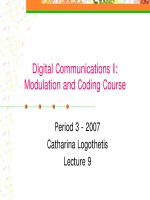
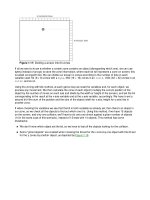
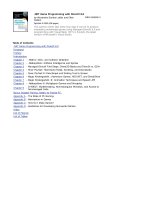


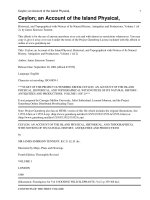
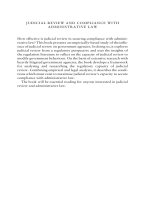
![the book of audacity [electronic resource] record, edit, mix, and master with the free audio editor](https://media.store123doc.com/images/document/14/y/zp/medium_zpu1401474957.jpg)
